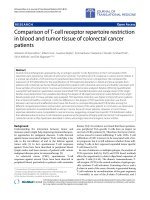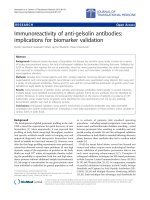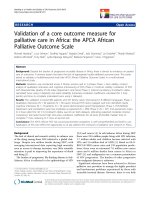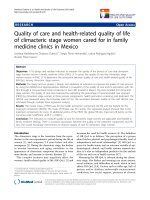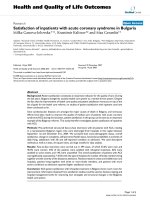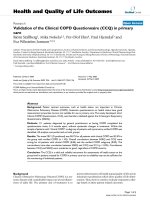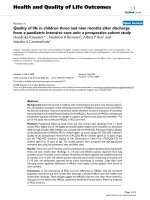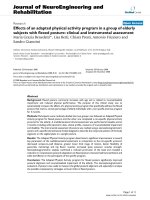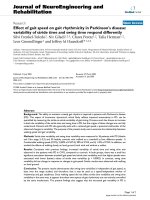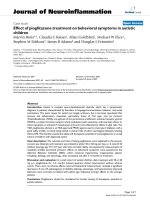báo cáo hóa học: " Quality of care and health-related quality of life of climacteric stage women cared for in family medicine clinics in Mexico" pot
Bạn đang xem bản rút gọn của tài liệu. Xem và tải ngay bản đầy đủ của tài liệu tại đây (466.5 KB, 12 trang )
RESEARC H Open Access
Quality of care and health-related quality of life
of climacteric stage women cared for in family
medicine clinics in Mexico
Svetlana Vladislavovna Doubova Dubova
1*
, Sergio Flores-Hernández
2
, Leticia Rodriguez-Aguilar
1
,
Ricardo Pérez-Cuevas
1
Abstract
Objectives: 1) To design and validate indicators to measure the quality of the process of care that climacteric
stage women receive in family m edicine clinics (FMC). 2) To assess the quality of care that climacteric stage
women receive in FMC. 3) To determine the association between quality of care and health-related quality of life
(HR-QoL) among climacteric stage women.
Methods: The study had two phases: I. Design and validation of indicators to measure the quality of care process
by using the RAND/UCLA Appropriateness Method. II. Evaluation of the quality of care and its association with HR-
QoL through a cross-sectional study conducted in two FMC located in Mexico City that included 410 climacteric
stage women. The quality of care was measured by estimating the percentage of recommended care received
(PRCR) by climacteric stage women in three process components: health promotion, screening, and treatment. The
HR-QoL was measured using the Cervantes scale (0-155). The association between quality of care and HR-QoL was
estimated through multiple linear regression analysis.
Results: The lowest mean of PRCR was for the health promotion component (24.1%) and the highest for the
treatment component (86.6%). The mean of HR-QoL was 50.1 points. The regression analysis showed that in the
treatment component, for every 10 additional points of the PRCR, the global HR-QoL improved 2.8 points on the
Cervantes scale (coefficient -0.28, P < 0.0001).
Conclusion: The indicators to measure quality of care for climacteric stage women are applicable and feasible in
family medicine settings. There is a positive association between the quality of the treatment component and HR-
QoL; this would encourage interventions to improve quality of care for climacteric stage women.
Introduction
The climacteric stage is the transition from the repro-
ductive to the non-rep roductive period during the life of
women [1], and comprises 2-8 years before and after
menopause [2]. During the clima cteric stage, the decline
in ovarian hormones and aging contribute to the
appearance of climacteric symptoms, decrease in bone
mass density, and increase in chronic diseases [2].
This complex scenario may negatively affect the
woman’s healt h-related quality of life (HR-QoL) [3] and
increases her need for health services [4]. The definition
of HR-QoL is as follows: “the perception of a person
about his/her physical and psychological health, level of
independence and social relationships” [5]. HR -QoL is a
proxy for health status, and an outcome variable of epi-
demiological, clinical, and health systems research stu-
dies; it is also an independent predictor for the analysis
of the use and cost of health services [6,7].
Measuring the HR-Q oL is relevant during the climac-
teric stage. Hot flashes and swea ting can cause anxiety,
social isolation, and difficulties at work, which in turn
affects HR-QoL [3,8]. Factors such as older age, lack of
partnerand/orchildren,unfavorable socioeconomic
conditions, low social support, presence of chronic
* Correspondence:
1
Unidad de Investigación Epidemiológica y Servicios de Salud Centro
Médico Nacional Siglo XXI, Instituto Mexicano del Seguro Social, México DF,
México
Doubova Dubova et al. Health and Quality of Life Outcomes 2010, 8:20
/>© 2010 Doubova (Dubova) et al; licensee BioMed Central Ltd. This is an Open Access article distributed under the terms of the Creative
Commons Attribu tion License ( which permits unrestricted use, distribution, and
reproduction in any medium, provided the original work is properly cited.
diseases, obesity, and unhealthy lifestyles are associated
with low HR-QoL as well [9-11].
Reports from clinical trials have shown that hormone
therapy (HT) decre ases climacteric symptoms and has a
positive effect on HR-QoL [9,12,13]. However, there are
no studies aimed at measuring the quality of health care
that climacteric stage women receive and its relationship
with HR-QoL.
Thequalityofhealthcareisamultidimensionalcon-
cept that includes “ the degree to which health services
for individuals and populations increase the likelihood
of desired health outcomes and are consistent with cur-
rent professional knowledge” [14]. The approach to
assess quality should address either individual or popu-
lation perspectives; in both, it is appropriate to include
in the assessment any of the usual three dimensions:
structure, process, and outcomes [15].
Process of care is the actual provision and recepti on of
care through interactions between users and providers. At
the individual level, measuring the quality of the process
of care through indicators is a robust approach [16]. The
indicators can measure d ifferent components of the pro-
cess of care, and should be constructed upon standards of
care that follow systematic methods based on scientific
evidence and/or expert opinion, and should be replicable.
The indicators allow valid judgments of the quality of care
to be reached and, although they do not provide definitive
answers, allow the identification of potential problems
during the provision of health care [17].
The growing number of climacteric stage women and
the increasing body of knowledge about the complexity
of their health needs are raising new requirements for
health services.
Health care for climacteric stage women should be
comprehensive. This comprises the provision of hor-
mone therapy (HT) when appropriate for climacteric
symptoms, and should include counseling about climac-
teric and menopause, promotion of a healthy lifestyle,
and screening, diagnosis, and treatment of chronic dis-
eases. These components must fulfill standards of care
that can meet the expectation to achieve a positive effect
on the health status and HR-QoL of women.
To build u p the evidence on this topic, this study had
the following objectives: 1) To design and validate indica-
tors to measure the quality of the process of care that cli-
macteric stage wome n receive in family medicine clinics.
2) To assess the quality of care that climacteric stage
women receive in family medicine clinics. 3) To deter-
mine the association between quality of care and health-
related quality of life among climacteric stage women.
Methods
The study was conducted in two phases: I. Design and
validation of indicators to measure the quality of care
that climacteric stage women receive in family medicine
clinics. II. Assessment of the quality of care and of its
association with HR-QoL in climacteric stage women.
Phase I
To design and validate indicators, we used the modified
version of the RAND/UCLA Appropriateness Metho d
[18]. This method combines expert opinion and sys-
tematic literature review of scientific evidence [19].
The method comprised the following activities:
i) Systematic search and review of the literature to
collect scientific evidence regarding the care process
activities that cl imacteric stage women should receive at
the family medicine clinic. The databases of Medline,
Ovid, Cochrane Library, National Institute for Clinical
Excellence, and World Health Organization covering the
period 1990-2008 were consulted. The entries for the
search were “ climacteric” and/or “menopausal” and/or
“po stmenopausal women,”“quality of care i ndicators”
and “guidelines,” and “ family medicine clinics” or “pri-
mary care services.”
We identified five systematic reviews, four meta-ana-
lyses, and 128 publications that included clinical practice
guidelines, clinical trials, and cohort, case-control and
cross-sectional studies relevant to answering the scienti-
ficquestion.ThecriteriaofSaslowwereusedtoscruti-
nize and classify the literature according to the study
type and the level of evidence [20].
The systematic literature review allowed the identifica-
tion of three key components of the process delivered to
climacteric stage women: health promotion, screening,
and treatment. Within each component, the critical
activities to achieve a positive effect on women’shealth
were identified. The research group pro posed 16 indica-
tors to evaluate the quality of the process of care
ii) An expert panel was integrated by two gynecolo-
gists who specialized in climacteric and menopause, two
health systems researchers, and two family doctors. All
had proven experience in clinical and health system
research, and in the development of clinical guidelines/
indicators. Each panelist received by e-mail the informa-
tion about the study objectives, a list of proposed indica-
tors, and the relevant literature. Panelists were asked to
validate the indicators by assigning a value from 1 to 9
(1 = definitely not valid and 9 = definitely valid). The
classification of the validity of the indicators followed
the criteria of Shekelle [21]. The panelists had to use
these criteria to individually rate the proposed indica-
tors. To consider an indicator valid, the median panel
rating was set to ≥ 7. This decision was in accordance
with a published study [21].
After two e-mail rounds of ranking , one vis-à-vis
meeting, and a review for coherence and content valid-
ity, a final set of 14 indicators was integrated (Table 1).
Doubova Dubova et al. Health and Quality of Life Outcomes 2010, 8:20
/>Page 2 of 12
Table 1 Indicators of quality of care that climacteric stage women receive in family medicine clinics
Indicator Formula
I. Health promotion
1. Counseling about climacteric stage and menopause in the last
year
Number of climacteric stage women who received counseling about climacteric
stage, menopause and self-care related activities by the family doctor or other
health professionals, in the last year/Total number of women in the sample × 100
2. Nutritional counseling in the last year Number of climacteric stage women who received nutritional counseling by the
family doctor or other health professionals, in the last year/Total number of
women in the sample × 100
3. Advice on regular leisure time physical activity in the last year Number of climacteric stage women who received advice on regular leisure time
physical activity by the family doctor or other health professionals, in the last
year/Total number of women in the sample × 100
4. Smoke cessation counseling in the last year Number of current smokers climacteric stage women who received smoke
cessation counseling by the family doctor or other health professionals, in the last
year/Total number of actively smoking women in the sample × 100
II. Screening
1. Deliberate search of climacteric symptoms in the last year Number of climacteric stage women who were asked by the family doctor about
climacteric symptoms in the last year/Total number of women in the sample ×
100
2. Screening for overweight and obesity by calculating the body
mass index (BMI) in the last year
Number of climacteric stage women who received overweight and obesity
screening through the BMI calculation by the family doctor in the last year/Total
number of women in the sample × 100
3. Screening for hypertension by measuring the systolic and
diastolic blood pressure in the last year
Number of climacteric stage women that received hypertension screening
through measuring the systolic and diastolic blood pressure by the family doctor
or other health professionals, in the last year/Total number of women in the
sample × 100
4. Screening for diabetes by measuring fasting plasma glucose in
the last year
Number of climacteric stage women who received diabetes screening through
fasting plasma glucose measurement, in the last year/Total number of women in
the sample × 100
5. Screening for breast cancer through mammography in the
last 2 years
Number of climacteric stage women who received breast cancer screening
through mammography, in the last 2 years/Total number of women in the
sample × 100
6. Screening for cervical cancer through Pap test in the last 3
years in women without a history of total hysterectomy
Number of climacteric stage women without a history of total hysterectomy for
benign disease who received cervical cancer screening through Pap test, in the
last 3 years/Total number of women in the sample without a history of total
hysterectomy × 100
III. Treatment
1. Appropriate indication of oral hormone therapy (HT) a) Number of women with moderate or severe vasomotor symptoms 7/day ≥ (at
the time of the interview or the time to start oral HT) and without HT
contraindications, who receive oral HT
b) Number of women with moderate or severe vasomotor symptoms <7/day(at
the time of the interview or the time to start oral HT), or with mild symptoms or
without vasomotor symptoms who do not receive oral HT/Total number of
women in the sample × 100
2. Appropriate indication of vaginal HT a) Number of women with moderate or severe vaginal atrophy symptoms and
without oral HT who receive vaginal HT
b) the number of women without moderate to severe vaginal atrophy symptoms
or with oral HT who do not receive vaginal HT/Total number of women in the
sample × 100
3. Appropriate prescription of oral HT Number of women receiving oral HT prescription appropriately according to the
drug scheme, dose, schedule and duration of the treatment/Total number of
women in the sample receiving oral HT × 100
4. Information on risks and benefits of oral HT Number of women who were prescribed oral HT and who received information
about its purpose, benefits and risks/Total number of women in the sample
receiving oral HT × 100
Doubova Dubova et al. Health and Quality of Life Outcomes 2010, 8:20
/>Page 3 of 12
Phase II
From November 2008 to March 2009, we conducted a
cross-sectional study in two Instituto Mexicano del
Seguro Social (IMSS) family medicine clinics (FMC)
located in Mexico City. The FMC wer e randomly
selected from the list of existing FMC in Mexico City.
Oneclinicwasinthesouthofthecityandtheotherin
the north. Both clinics had similar characteristics, such
as the number of examining rooms and people covered.
The IMSS is a social security system for workers in
the formal market; ~48 million Mexicans a re affiliated
with this institution [22].
The study population was women in climacteric stage
aged 45-59 years attending the FMC. To identify these
women we used th e definition o f the “ Clinical Practice
Guideline o n the Menopause and Po stmenopause” [2]; also
we took into account t hat the mean age in which the
menopause occurs among Mexican women is 48 years
[23]. Besides the age interval, we also asked postmenopau-
sal candidates the date of the last menstrual period and we
only included participants who had their last period no
longer than eight years ago. Other inclusion criteria were:
at least three visits to the family do ctor in the last year; not
suf fering from type 2 diabetes, hypertension, d epression,
and/or cancer; being with a stable life partner and agreeing
toparticipateinthestudybysigningtheinformedconsent.
Study variables
The dependent variable was HR-QoL, and this was mea-
sured with the Cervantes scale [24]. This scale is a spe-
cific HR-QoL in strument for menopausal women. The
scale has 31 questions and covers four domains: meno-
pause and health, psychological domain, sexuality, and
couple relationship. The highest value for the global
score is 155 points, which means low HR-QoL, and the
lowest value is 0, which means high HR-QoL.
The independent variable was quality of care, which
was measured by ascertaining the percentage of recom-
mended care received [25]. This was estimated for each
care process component: health promotion, screening,
and treatment (Table 1). It was obtained by calculating
asimpleproportion,withthesumofindicatorsthat
women received as the numerator and the total number
of the recommended indicators as the denominator.
The covariates were:
a) Women’s general characteristics: Age, schooling,
and employment status, which included whether she
was involved in paid work.
b) Lifestyle: Healthy diet [26-28] which included the
daily consumption of fruits, vegetables, and dairy pro-
ducts, and non-consumption of carbonated beverages;
leisure time physical activity (PA) [29] where regular
was defined as moderate intensity if done for ≥ 30
minutes/day ≥ 5 days/week or vigor ous intensit y if
done three times a week with a duration of 20 minutes
per session, irregular was defined as carrying out less
than regular PA, or inactivity. Smo king status was
focused on current smokers and we registered the
number of cigarettes actually sm oked per day among
those that answered positively. Alcohol consumption
was initially classified as non-drinkers (never drink
alcohol), occasional drinkers (drink rarely or less than
once a week), moderate drinkers (from 1 to 14 drinks
per week) and heavy drinkers (more than 14 drinks
per week) [30]. It has been reported that moderate
alcohol consumption has a positive association with
HR-QoL in middle aged women [31]; therefore, we
combined non-drinkers and occasional drinkers in a
single group and presented the data for moderate alco-
hol consumption only.
c) Nutritional status was measured by body mass
index (BMI) and classified into groups of normal
weight (BMI of 18.5-24.9 kg/m
2
), overweight (BMI
of 25.0 to 29.9 kg/m
2
), or obese (BMI ≥ 30.0 kg/m
2
).
d) Social support (SS) was measured by applying the
DUKE-UNC-11 questionnaire [32]. This question-
naire evaluates confidential SS (possibility of having
people to co mmunicate with) with a minimum score
of 7 points (low confidential SS) and a maximum
score of 35 points (high confidential SS); and affective
SS (demonstration of love, affection, and empathy)
with a minimum score of 4 (low affective SS) and a
maximum score of 20 points (high affective SS).
e) Medical and reproductive history: Presence of
chronic diseases, number of pregnancies and living
children, and menopause (one year after the last men-
strual period). Type of menopause was classified as
natural or surgical, age at onset of menopause; time
elapsed since menopause, presence and type of climac-
teric symp toms , and number of visits wit h the family
doctor in the last year. The severity of vasomotor
symptoms and vaginal atrophy symptoms was classi-
fied using the criteria proposed by the Department of
Health and Human Services Food and Drug Adminis-
tration [33], which are based upon women’s self-report,
and define the symptoms as mild, moderate, or severe.
f) Satisfaction with care received at the FMC was
measur ed with the general question of how satisfied
are you with the care you have received at the FMC?
The possible a nswers were very satisfied, satisfied,
neither satisfied nor unsatisfied, unsatisfied, and very
unsatisfied.
Sample size
We estimated a sample size of 400 women to evaluate
the possible association between HR-QoL and q uality of
Doubova Dubova et al. Health and Quality of Life Outcomes 2010, 8:20
/>Page 4 of 12
care. The sample size was estimated by using the for-
mula to tes t the mea n of a normal distribution [34]. A
mean decrease of at least 5 points on the global Cer-
vantes scale score per 10% increase in the quality of
care received was considered to be clinically relevant.
The assumptions included a mean global HR-QoL score
of 51.75 points (standard d eviatio n of 23 .1 points) [2 4],
a error = 0.05, 80% power, and 10% of possible non-
respondents (this means that a respondent answered
less than 80% of the questionnaire).
Study description
In each FMC, the nurse identified candidates in the
waiting room, explained the purpose of the study and of
the interview, and asked for her signed informed con-
sent. If the candidate agreed to participate, the nurse
performed the interview. The questionnaires used dur-
ing the interview were the Cervantes scale, the DUKE-
UNC-11 questionnaire, and a structured questionnaire
to collect general information and data to measure qual-
ity of care.
All questionnaires, including the Cervantes scale, were
pretested in 25 women in climacteric stage regarding
their understanding of the questions. The supervisory
nurse and/or one of the researchers (SVD) reviewed the
previous year’s clinical notes in the electronic medical
record to verify the care that each woman received.
The project was approved by the National Research
and Ethics Committee of the IMSS (number 2008-785-
014).
Statistical analysis
The descriptive analysis consisted of obtaining measures
of central tendency and dispersion for quantitative vari-
ables; in the case of categorical variables, absolute and
relative frequencies were obtained.
For the descriptive analysis of the HR-QoL, the mean
and standard deviation (SD) of global and particular
domain scores were obtained. We also categorized HR-
QoL global score and domain scores into: 1) low HR-
QoL, severe problem level (+2SD); 2) moderately low
HR-QoL, high problem level (+1SD and +2SD); 3) regu -
lar HR-QoL, low-medium problem level (+1SD and
-1SD); and 4) high HR-QoL, without problems (-1SD)
[23]
The association between global HR-QoL score and the
percentage of recommended care received for each com-
ponent of care (health promotion, screening and treat-
ment), as well as for each of the covariates was
evaluated through the Spearman correlation test.
To determine the magnitude of the adjusted associa-
tion between HR-QoL global score and each component
of quality of care, we used multiple linear regression
analysis. The model included conceptually releva nt vari-
ables (schooling, confide ntial and affec tive support, lei-
sure time physical activity, healthy diet, presence of
chronic disease, body mass index, menopause, and
satisfaction with health care) that resulted in p ≤ 0.20 in
the bivariate statistical analysis. The method used for
modeling was backwards. The covariate presence/
absence of menopause was i ncluded as an adjustment
variable and it was not statistically signific ant, although
given its clinical importance it was maintained during
the modeling process. It was also tested if menopause
influenced the association of interest (relationship
between HR-QoL global score and each component of
quality of care). The analysis tested the interactions
between each component of quality of care and meno-
pause; such interacti ons were not statistically significa nt
and were not included in the final model.
Once the final model was obtained, the error terms
were generated, the assumptions of linearity, normality,
and equal variance were tested, and the goodness-of-fit
of the regression line was confirmed.
The analysis was performed with the Stata 8.0 statisti -
cal software (Stata 8.0, Stata Corp; College Station, TX).
Results
A total of 424 women met the inclusion criteria, of
which 2% refused to participate due to lack of time to
answer the interview questions. Of the 416 women
interviewed, 6 (1.4%) were excluded because they had
no medical notes of consultations during the last year in
their electronic medical records. The final analysis
included 410 women.
General characteristics, lifestyle, nutritional status, and
social support (Table 2)
The median age was 49 years, and the median schooling
was at secondary level. Of the respondents, 64.9% were
devoted to home and had no paid work.
As for lifestyle, the results show that most of women
had an unhealthy lifestyle; one in five women reported
having a healthy diet, and one in four reported regular
physical activity. Only 6.7% had both a healthy diet and
regular leisure time physical activity; 18.3% were current
smokers, they smoked a median of three cigarettes per
day. Most of interviewees were non-drinkers or occa-
sional drinkers, only 2 % reported moderate consump-
tion. It was noted that a high proportion of participants
were overweight or obese.
On average, the interviewees received moderate social
support. The mean score for confidential support was
23.1 on a scale of 7 to 35 points and the mean score for
emotional sup port was 15.5 points on a scale of 4 to 20
points.
Doubova Dubova et al. Health and Quality of Life Outcomes 2010, 8:20
/>Page 5 of 12
Medical and reproductive history, and climacteric
symptoms (Table 3)
Half of participating women suffered from one chronic
condition, mainly musculoskeletal system diseases
(41.9%), and nutritional and metabolic disorders such as
dyslipidemia (19.0%).
As for reproductive history, the median number of
pregnancies and living children was three. Half of the
participants were menopausal, of which most had nat-
ural menopause. The median age at natural menopause
was 4 9 years and at surgical menopause was 45.5 years;
themediantimeelapsedsincemenopausewasthree
years. The most frequent climacteric symptoms were
changes in the menstrual cycle, hot flashes, sweating,
and dyspareunia; very few reported having moderate or
severe vasomotor s ymptoms, with a frequency of 7 or
more times a day; 22% had moderate to severe s ymp-
toms of vaginal atrophy. Women attended a median of
six visits to their family doctors in the last year.
Quality of care and satisfaction with care (Table 4)
The quality of care was assessed in three domains: health
promotion, screening, and treatment. Regarding health
promo tion, a low percentage of participants had received
counseling about climacteric and menopause, nutrition,
leisure time physical activity, and smoking cessation.
The screening component showed important limita-
tions in several components. The family doctor asked
about climacteric symptoms in 37.8% of participants;
ascertainment of overwe ight and obesity were registered
in 3.4%, and screening for breast cancer in 42.2%.
Hypertension, diabetes, and cervical cancer screening
tests were performed in most women (99.3%, 88.3%, and
91.9%, respectively).
The treatment component indicated that most women
had appropriate indication of vag inal and oral HT (94.6%
and 81.0%, respectively). While 51.6% of 31 women
receiving oral HT had an appropriate prescription in
terms of scheme, dose, and time schedule, 38.7% had
received information about the risks and benefits of HT.
The health promotion component had the lowest
mean percentage of recommended care ( 24.1%), while
the treatment component had the highest (86.6%). Most
of the interviewed women (64.9%) reported being satis-
fied with the care received at the FMC.
Health-related quality of life (Figure 1)
Women rated their global HR-QoL as follows: high HR-
QoL, 15.1%; regular HR-QoL, 67.6%; moderately low
HR-QoL, 13.4%; and low HR-QoL, 3.9%. The mean glo-
bal HR-QoL score was 50.1 points (SD 24.7). The analy-
sis within the domains shows that more women in the
couple relationship domain reported high HR-QoL
(32.3%) compared with the other domains; in the sexual
domain, nobody reported low HR-QoL.
Relationship between health-related quality of life and
quality of care (Table 5)
The quality of treatment was significantly associated
with a better rating of global HR-QoL after adjusting for
other variables. The higher mean perc entage of re com-
mended care received in the treatment component
reduced the mean global HR-QoL score on the Cer-
vantes scale (coefficient -0.28, P < 0.0001). This means
that for each 10 percentage points more of recom-
mended care received in t he treatment component, the
rate of HR-QoL improved by 2.8 points on the Cer-
vantes scale. The association betwee n HR-QoL and the
health promotion and screening components was not
statistically significant.
Discussion
The health of women in the climacteric stage is a com-
plex matter that requires further attention from health
services [8]. Some of t he health probl ems that a climac-
teric woman suffers ca n be prevented or timely diag-
nosed, thus allowing the control or mitigation of the
potential consequences. Promoting high quality care
based on scientific evidence is critical; this helps women
to age in better health.
Table 2 General characteristics, lifestyle, nutritional
status, and social support
Variables n = 410
n (%)
I. General characteristics
Years of age, median (minimum- maximum) 49 (45-59)
Years of schooling, median (minimum- maximum) 8 (0-20)
Paid work 144 (35.1)
II. Lifestyle
Healthy diet 85 (20.7)
Leisure time physical activity
Regular 102 (24.9)
Irregular 67 (16.3)
Inactivity 241 (58.8)
Current smokers 75 (18.3)
Number of cigarettes per day, median
(minimum- maximum)
3 (1-15)
Moderate alcohol intake 8 (2.0)
III. Nutritional status
Body mass index, kg/m
2
, mean ± SD 29.1 ± 4.3
Normal weight 70 (17.1)
Overweight 189 (46.1)
Obesity 151 (36.8)
IV. Social support
Confidential, mean ± SD 23.1 ± 6.5
Affective, mean ± SD 15.5 ± 3.7
Doubova Dubova et al. Health and Quality of Life Outcomes 2010, 8:20
/>Page 6 of 12
We designed and validated 14 indicators addressing
health promotion, screening, and treatment to assess the
quality of the process of care that climacteric stage
women receive in family medicine clinics. The indicators
should be feasi ble, available, and continuous. The infor-
mation for the present study came from two sources:
interviews with climacteric stage women and medical
records. Combining both sources provided information
that is more reliable but increased the cost of data col-
lection since trained personnel was required. In practice,
these indicators allowed the analysis of the quality of
care process with a swift and replicable methodology.
The evaluation of the quality of care pointed out flaws
in the processes of health promotion, screening, and
treatment. This finding is similar to the results of other
studies reporting that users receive only about half of
the recommended actions [35,36].
Health promotion interventions for climacteric stage
women include motivation to quit smoking, to fo llow a
healthy diet, and to do regular leisure time physical
activity. Carrying out these activities improves their
health status, reduces mortality due to chronic diseases,
and maintains bone mineral density and muscle strength
[26-28,37,38]. Counseling about climacteric stage
increases women’s knowledge about it and receptiveness
about self-care. Informed women can cope better w ith
the physiological and emotional changes that occur at
this stage and improve their lifestyle [39,40]. In our
study, the evaluation of health promotion revealed ser-
ious limitations. Only one out of every ten women fol-
lowed a healthy diet and did regular leisure time
physical activity. Most of those with unhealthy lifestyles
had not received information to improve it.
In family medicine clinics, all members of the health
team should perform health promotion activities: medi-
cal doctors, nurses, social workers, nutritionists, etc. Ide-
ally, these activities should be complementary, and the
health team members should reinforce them continually.
Previous studies performed at IMSS have reported that
health promotion is inadequate and requires substantial
improvements [41].
Screening of diseases allows timely diagnosis and
treatment, thus increasing the probability of b etter
health outcomes. The present study showed that women
underwent only half of the recommended screening
activities. Screening for overweight/obesity was poor,
despite it being easy to perform and the high prevalence
of obesity among Mexican women [42]. This finding
suggests the need to encourage health services to
improve the screening activities and to educate women
in this age group to increase the informed demand for
preventive care.
During the last years, the appropriate indication and
prescription of hormone therapy have been debated
[43]. Evidence-based clinical guidelines are available for
managing climacteric women. These guides provide
recommenda tions for the indication and appropriate use
of hormone therapy, while reducing the risk of adverse
events. In our study, we found that the treatment
component was close to the current recommendations,
but only half of the women were receiving appropriate
prescription of oral HT.
Table 3 Medical and reproductive history, climacteric
symptoms, and number of consultations with family
doctor
Variable n = 410
n (%)
I. Medical and reproductive history
Presence of chronic disease 202 (49.3)
Number of pregnancies, median (min- max) 3 (1-9)
Number of living children, median (min- max) 3 (0-9)
Menopause 224 (54.6)
Type of menopause n = 224
Natural 162 (72.3)
Surgical 62 (27.7)
Age in which menopause happened, median
(min- max)
n = 224
Natural 49 (38-56)
Surgical 45.5 (38-53)
Time elapsed after menopause, years 3 (0-8)
II. Climacteric symptoms n = 410
Hot flashes 205 (50.0)
Sweating 181 (44.1)
Insomnia 169(41.2)
Dysuria 91 (22.2)
Vaginal dryness 161 (39.3)
n = 186
Changes in the menstrual cycle in pre-menopause
women
98 (52.6)
n = 352
Dyspareunia and/or vaginal bleeding in sexual active
women
101 (28.7)
Severity and frequency of vasomotor symptoms n = 410
Absence 192 (46.8)
Mild 46 (11.2)
Moderate
< 7/day 129 (31.5)
≥ 7/day 2 (0.5)
Severe
< 7/day 32 (7.8)
≥ 7/day 9 (2.2)
Severity of vaginal atrophy symptoms n = 410
Absence 219 (53.4)
Mild 101 (24.6)
Moderate 40 (9.8)
Severe 50 (12.2)
III. Number of consultations with a family doctor
during the last year, median (min- max)
6 (3-20)
Doubova Dubova et al. Health and Quality of Life Outcomes 2010, 8:20
/>Page 7 of 12
Table 4 Quality of care
†
and satisfaction with care
Variable n = 410
I. Health promotion n (%)
1. Counseling about climacteric and menopause 52 (12.7)
2. Nutritional counseling 59 (14.4)
3. Advice on regular leisure time physical activity 178 (43.4)
4. Smoke cessation counseling in current smokers n=75
23 (30.7)
II. Screening n = 410
1. Deliberate search of climacteric symptoms 155 (37.8)
2. Screening for overweight/obesity 14 (3.4)
3. Screening for hypertension 407 (99.3)
4. Screening for diabetes 362 (88.3)
5. Screening for breast cancer 173 (42.2)
6. Screening for cervical cancer in women without total hysterectomy n = 347
319 (91.9)
III. Treatment n = 410
1. Appropriate indication of oral HT 388 (94.6)
a) Women with moderate or severe vasomotor symptoms ≥ 7/day (at the time of the interview or the time to start oral HT)
and without contraindications for HT
n=37
oral HT indicated appropriately 20 (54.0)
oral HT not indicated 17 (46.0)
b) Women with moderate or severe vasomotor symptoms <7/day (at the time of the interview or the time to start oral HT),
with mild symptoms or without vasomotor symptoms
n = 373
oral HT indicated 5 (1.4)
oral HT not indicated appropriately 368 (98.6)
2. Appropriate indication of vaginal HT 332 (81.0)
a) women with moderate or severe vaginal atrophy symptoms and without oral HT n = 87
vaginal HT indicated appropriately 9 (10.3)
vaginal HT not indicated 78 (89.7)
b) women without moderate to severe vaginal atrophy symptoms or with oral HT n = 323
vaginal HT indicated 0 (0.0)
vaginal HT not indicated appropriately 323 (100.0)
Women receiving oral HT n=31
3. Appropriate prescription of oral HT 16 (51.6)
4. Information on risks and benefits of oral HT 12 (38.7)
n = 410
Percentage of recommended care received % mean ± SD
Health promotion 24.1 ± 28.1
Screening 59.5 ± 16.8
Treatment 86.6 ± 22.9
Satisfaction with care received at the FMC n (%)
Very satisfied 66 (16.1)
Satisfied 200 (48.8)
Neither satisfied nor unsatisfied 90 (22.0)
Unsatisfied 41(10.0)
Very unsatisfied 13 (3.2)
†
For complete information about the formula of each quality of care indicator, please see Table 1.
Doubova Dubova et al. Health and Quality of Life Outcomes 2010, 8:20
/>Page 8 of 12
The information/education of women about the pur-
pose, benefits, and potential adverse events of HT con-
tributes to increased adherence to HT and the timely
identification of the adverse events. The flaws of the
treatment component, such as inappropriate prescrip-
tion and poor information, stress the need to update the
medical staff and to evaluate the quality of care in a
continuous way. In addition, it is advisable to search for
feasible alternatives to motivate providers to deliver
high-quality care. The use of incentives, either in kind
or monetary, is a viable approach. In addition, the defi-
nition of standards is necessary as this allows the quality
to be evaluated in a reliable way; our data would help in
defining the standards of care at the local level. The
implementation of standards of care and evaluation
activities should be tailored to the characteristics of the
services that are being evaluated.
In our study, we used the Cervantes scale to measure
HR-QoL because this scale comprehensively addresses
the main domains of the health of women in climac-
teric stage. The questionnaire was applied as rigorously
as possible, assuring that all participants understood
and answered all the questions. In our sample, the
mean value for the global HR-QoL score was similar
to those reported for Spanish women [24]. It is notice-
able that no woman reported severe problems in the
Figure 1 Health-related quality of life measured by Cervantes scale (n = 410).
Doubova Dubova et al. Health and Quality of Life Outcomes 2010, 8:20
/>Page 9 of 12
sexuality domain. It is possible that due to sensitive
nature of the subject, they were not completely open
to answer such question. In another study in Spain
that used the Cervantes Scale, it was observed that the
answers of women in the sexuality domain were differ-
ent when they w ere interviewed directly, than when
they answered anonymously the questionnaire. In the
open interview they minimized the problems in the
sexual domain [44]. In our study, all participants
answered to an interviewer. Our findings allow the
assumption that the Cervantes scale can be applied to
Mexican women but should be validated within the
Mexican context.
There is an ongoing trend toward ascertaining the
relationship between quality of care and health out-
comes [45,46]. The present study found that the treat-
ment component was associated with better global HR-
QoL. This can be due to the effect of the drugs on redu-
cing the climacteric symptoms, thus resulting on
improving HR-QoL in the short term; in contrast, the
positive effect of the health promotion and screening
comp onents would happen in the long term. It is possi-
ble that the relationship between these components and
HR-QoL is not straightforward. A number of variables
intervene, such as changes in lifestyle, women’s endow-
ment, etc.
This cross-sectional study has several lim itations. It is
possible that the evaluation of the quality of care is lim-
ited because, in Mexico, the women who use health ser-
vices often have a chronic illness and require specific
attention. In this study, the quality of care assessment
was limited to the climacteric stage and did not assess
the process of care for other health problems. The study
evaluated the quality of care only in IMSS-affiliated
women; this affects its external validity. It would be per-
tinent to consider the a pplicability of the indicators in
other health care institutions. This is reasonable because
quality measurements should consider the local condi-
tions. In ad dition, the probability of misclassifying the
indicators for evaluating the appropriate oral and vaginal
HT indication exists; each indicator combines two parts
1) appropriate indication for women who need this ther-
apy and 2) no indication for women who do not need it.
Because most of the women in the sample do not need
to receive either oral or vaginal HT, the results reflect
the proper “ no in dication” more, so the association
between HR-QoL and quality of ca re in the treatment
component was probably overestimated. Also, to evalu-
ate the HR-QoL we used the Cervantes scale, which has
questions about the couple relationship, which in turn
implies that the woman should have a partne r. This
could represent a limitation in the generalizability of the
study, given that it has been reported in Mexico that
about 21% of women of this age do not have a partner
[41].
In conclusion, the indicators developed to measure the
quality of care process for climacteric stage women are
applicable and feasible. Its application in this study
showed that health care in this population is limited in
the health promotion, screening, and treatment compo-
nents. There is a positive association between the quality
of treatment and HR-QoL, which can encourage the
development of interventions aimed at improving the
performance of health services. It is advisable to con-
sider the possibility of designing future interventions
with a holistic approach toward improving the quality of
care for women at this stage.
Acknowledgements
The authors would like to thank to Dr. Sebastián Carranza Lira, Dr. Manuel
Cortes, Dr. José Luis Pozos Cavanzo, Dr. Carlos Duran and Psychologist Jesus
Vertiz for their valuable collaboration in designing and validating the quality
of care indicators.
Table 5 Relationship between health-related quality of life
†
and quality of care
Coefficient Confidence intervals at 95% P value
Percentage of recommended care received:
Health promotion -0.01 -0.09; 0.06 0.722
Screening -0.09 -0.21; 0.04 0.158
Treatment -0.28 -0.37; -0.19 0.000
Schooling -1.40 -1.98; -0.83 0.000
Leisure time physical activity
Regular -9.83 -14.92; -4.76 0.000
Irregular -6.01 -12.04; 0.02 0.051
Confidential support -0.46 -0.85; -0.07 0.022
Affective support -1.23 -1.93; -0.54 0.001
Body mass index 0.54 0.06; 1.02 0.027
Absence of menopause -3.08 -7.28; 1.05 0.148
Satisfaction with health care in the FMC -3.72 -5.88; -1.57 0.001
†
Health-related quality of life measured with the Cervantes scale, where low scores indicate better HR-QoL.
Doubova Dubova et al. Health and Quality of Life Outcomes 2010, 8:20
/>Page 10 of 12
The study was sponsored by the Instituto Mexicano del Seguro Social, grant
number FIS/IMSS/PROT/501.
Author details
1
Unidad de Investigación Epidemiológica y Servicios de Salud Centro
Médico Nacional Siglo XXI, Instituto Mexicano del Seguro Social, México DF,
México.
2
Coordinación de Investigación en Salud, Centro Médico Nacional
Siglo XXI, Instituto Mexicano del Seguro Social, México DF, México.
Authors’ contributions
SVD and RPC contributed in conceptualizing the research, data analysis and
writing the paper. SFH contributed in the data analysis. LRA contributed in
supervising the fieldwork. All authors participated in the interpretation of
data, read, and approved the final version of this manuscript.
Competing interests
The authors declare that they have no competing interests.
Received: 24 November 2009 Accepted: 10 February 2010
Published: 10 February 2010
References
1. Utian WH: Ovarian function, therapy-oriented definition of menopause
and climacteric. Exp Gerontol 1994, 29:245-251.
2. Menopause and Postmenopause Working Group: Spanish Society of
Gynecology and Obstetrics. Spanish Association for the Study of
Menopause, Spanish Society of Family and Community Medicine,
Iberoamerican Cochrane Centre. Clinical Practice Guideline of Menopause
and Postmenopause. Barcelona 2004.
3. Satoh T, Ohashi K: Quality-of-life assessment in community-dwelling,
middle-aged, healthy women in Japan. Climacteric 2005, 8:146-153.
4. Guthrie JR, Dennerstein L, Taffe JR, Lehert P, Burger HG: The menopausal
transition: a 9-year prospective population-based study. The Melbourne
Women’s Midlife Health Project. Climacteric 2004, 7:375-389.
5. Utian WH, Janata JW, Kingsberg SA, Patrick LD: Determinants and
quantification of quality of life after the menopause: the Utian
Menopause Quality of Life score. The Menopause at the Millenium Taylor &
FrancisAso T, Yanaihara T 2000, 141-144.
6. Carey MS, Bacon M, Tu D, Butler L, Bezjak A, Stuart GC: The prognostic
effects of performance status and quality of life scores on progression-
free survival and overall survival in advanced ovarian cancer. Gynecol
Oncol 2008, 108:100-105.
7. Seid M, Varni JW, Segall D, Kurtin PS: Health related quality of life as a
predictor of pediatric healthcare costs: A two-year prospective cohort
analysis. Health Qual Life Outcomes 2004, 2:48.
8. Utian WH: Psychosocial and socioeconomic burden of vasomotor
symptoms in menopause: a comprehensive review. Health Qual Life
Outcomes 2005, 3:47.
9. Schwarz S, Völzke H, Alte D, Schwahn C, Grabe HJ, Hoffmann W, John U,
Dören M: Menopause and determinants of quality of life in women at
midlife and beyond: the Study of Health in Pomerania (SHIP). Menopause
2007, 14:123-134.
10. O’Dea I, Hunter MS, Anjos S: Life satisfaction and health-related quality of
life (SF-36) of middle-aged men and women. Climateric 1999, 2:131-140.
11. Daley A, Macarthur C, Stokes-Lampard H, McManus R, Wilson S, Mutrie N:
Exercise participation, body mass index and health-related quality of life
in women of menopausal age. Br J Gen Pract 2007, 57:130-135.
12. Nachtigall LE, Nachtigall MJ: Menopausal changes, quality of life and
hormone therapy. Clin Obstet Gynecol 2004, 2:485-488.
13. Koundi KL, Christodoulakos GE, Lambrinoudaki IV, Zervas IM, Spyropoulou A,
Fexi P, Sakkas PN, Soldatos CR, Creatsas GC: Quality of life and
psychological symptoms in Greek postmenopausal women: association
with hormone therapy. Gynecol Endocrinol 2006, 22:660-668.
14. Committee on Quality of Health Care in America: Crossing the Quality
Chasm: A new Health System for the 21st Century Washington, D.C: National
Academy Press 2001.
15. Campbell SM, Roland MO, Buetow SA: Defining quality of care. Soc Sci
Med 2000, 51:1611-1625.
16. Campbell SM, Braspenning J, Hutchinson A, Marshal MN: Improving the
quality of health care. Research methods used in developing and
applying quality indicators in primary care. BMJ 2003, 326:816-819.
17. Freeman T: Using performance indicators to improve health care quality
on the public sector: a review of the literature. Health Serv Manage Res
2002, 15:126-137.
18. Brook RH, Chassin MR, Fink A, Solomon DH, Kosecoff J, Park RE: A method
for the detailed assessment of the appropriateness of medical
technologies. Inn J Technol Assess Health Care 1986, 2:53-63.
19. Campbell SM, Hann M, Hacker J, Roland MO: Quality assessment for three
common conditions in primary care: validity and reliability of review
criteria developed by expert panels for angina, asthma and type 2
diabetes. Qual Saf Health Care 2002, 11:125-130.
20. Saslow D, Runowicz CD, Solomon D, Moscicki AB, Smith RA, Eyre HJ,
Cohen C: American Cancer Society Guideline for the Early Detection of
Cervical Neoplasia and Cancer. CA Cancer J Clin 2002, 52:342-362.
21. Shekelle PG, MacLean CH, Morton SC, Wenger NS: Assessing care of
vulnerable elders: methods for developing quality indicators. Ann Intern
Med 2001, 135:647-652.
22. Instituto Mexicano del Seguro Social: Memoria Estadística 2008. México DF
2008. [ />htm].
23. Malacara JM, Canto de Cetina T, Bassol S, Gonzalez N, Cacique L, Vera-
Ramirez ML, Nava LE: Symptoms at pre- and postmenopause in rural and
urban women from three States of Mexico. Maturitas 2002, 43:11-19.
24. Palacios S, Ferrer-Barriendos J, Parrilla JJ, Castelo-Branco C, Manubens M,
Alberich X, Marti A y el grupo Cervantes: Calidad de vida relacionada con
la salud en la mujer española durante la perimenopausia y
posmenopausia. Desarrollo y validación de la Escala Cervantes. Med Clin
(Barc) 2004, 122:205-211.
25. Higashi T, Wenger NS, Adams JL, Fung C, Roland M, McGlynn EA, Reeves D,
Asch SM, Kerr EA, Shekelle PG: Relationship between number of medical
conditions and quality of care. N Engl J Med 2007, 356:2496-2504.
26. AHA Scientific Statement: Diet and lifestyle recommendations revision
2006: a scientific statement from the American Heart Association
Nutrition Committee. Circulation 2006, 114:82-96.
27. North American Menopause Society: The role of calcium in peri- and
postmenopausal women: 2006 position statement of the North
American Menopause Society. Menopause 2006, 13:862-877.
28. Tucker KL, Morita K, Qiao N, Hannan MT, Cupples LA, Kiel DP: Colas, but
not other carbonated beverages, are associated with low bone mineral
density in older women: The Framingham Osteoporosis Study. Am J Clin
Nutr 2006, 84:936-942.
29. Haskell WL, Lee IM, Pate RR, Powell KE, Blair SN, Franklin BA, Macera CA,
Heath GW, Thompson PD, Bauman A: Physical activity and public health:
Updated recommendations for adults from the American College of
Sports Medicine and the American Heart Association. Med Sci Sports Exerc
2007, 39:1423-1434.
30. Clemens SL, Matthews SL, Young AF, Powers JR: Alcohol consumption of
Australian women: results from the Australian Longitudinal Study on
Women’s Health. Drug Alcohol Rev 2007, 26:525-535.
31. Powers JR, Young AF: Longitudinal analysis of alcohol consumption and
health of middle-aged women in Australia. Addiction 2008, 103:424-432.
32. Bellón Saameño JA, Delgado Sánchez A, Luna del Castillo JD, Lardelli
Claret P: Validez y fiabilidad del cuestionario de apoyo social funcional
Duke-UNC-11. Aten Primaria 1996, 18:153-163.
33. U.S. Department of Health and Human Services Food and Drug
Administration. Guidance for Industry: Estrogen and Estrogen/Progestin Drug
Products to Treat Vasomotor Symptoms and Vulvar and Vaginal Atrophy
Symptoms – Recommendations for Clinical Evaluation Center for Drug
Evaluation and Research (CDER) 2003 />DrugSafety/InformationbyDrugClass/UCM135338.pdf.
34. Rosner B: Sample size determination. Fundamentals of biostatistics Pacific
Grove, Ca: Duxbury RessRosner B , 5 2000, 236-243.
35. McGlynn EA, Asch SM, Adams J, Keesey J, Hicks J, DeCristofaro A, Kerr EA:
The quality of health care delivered to adults in the United States. N
Engl J Med 2003, 348:2635-2645.
36. Seddon ME, Marshal MN, Campbell SM, Roland MO: Systematic review of
studies of quality of clinical care in general practice in the UK, Australia
and New Zealand. Qual Health Care 2001, 10:152-158.
37. Eyre H, Kahn R, Robertson RM: Preventing cancer, cardiovascular disease
and diabetes: a common agenda for the American Cancer Society, the
American Diabetes Association and the American Heart Association. CA
Cancer J Clin 2004, 54:190-207.
Doubova Dubova et al. Health and Quality of Life Outcomes 2010, 8:20
/>Page 11 of 12
38. Kohrt WM, Bloomfield SA, Little KD, Nelson ME, Yingling VR: American
College of Sports Medicine Position Stand: physical activity and bone
health. Med Sci Sports Exerc 2004, 36:1985-1996.
39. Hunter M, O’Dea I: An evaluation of a health education intervention for
mid-aged women: Five-year follow-up of effects upon knowledge,
impact of menopause and health. Patient Educ Couns 1999, 38:249-255.
40. Jimenez de Luque MP, Serrano Monzó I, Sabaté Baruque I, Satrústegui
Sáez B, Azcona Montero C: Health education during menopause. A long-
range evaluation. Rev Enferm 2000, 23:26-31.
41. Vladislavovna-Doubova S, Pérez-Cuevas R, Reyes- Morales H: Self-rated
health among climacteric women affiliated to Instituto Mexicano del
Seguro Social. Salud Publica Mex 2008, 50:390-396.
42. Flores-Huerta S, Acosta-Cázares B, Gutiérrez-Trujillo G: ENCOPREVENIMSS
2003. Prevalence of low weight, overweight, general obesity and central
obesity. Rev Med Inst Mex Seguro Soc 2006, 44:55-62.
43. Shapiro S: Recent epidemiological evidence relevant to the clinical
management of the menopause. Climateric 2007, 10:2-15.
44. Castelo-Branco C, Palacios S, Ferrer-Barriendos J, Alberich X, the Cervantes
Study Group: Do Patients Lie? An Open Interview vs. a Blind
Questionnaire on Sexuality. J Sex Med 2009.
45. Higashi T, Shekelle PG, Adams JL, Kamberg CJ, Roth CP, Solomon DH,
Reuben DB, Chiang L, MacLean CH, Chang JT, Young RT, Saliba DM,
Wenger NS: Quality of care is associated with survival in vulnerable older
patients. Ann Intern Med 2005, 143:274-281.
46. Hanlon JT, Fillenbaum GG, Kuchibhatla M, Artz MB, Boult C, Gross CR,
Garrard J, Schmader KE: Impact of inappropriate drug use on mortality
and functional status in representative community dwelling elders. Med
Care 2002, 40:166-176.
doi:10.1186/1477-7525-8-20
Cite this article as: Doubova Dubova et al .: Quality of care and health-
related quality of life of climacteric stage women cared for in family
medicine clinics in Mexico. Health and Quality of Life Outcomes 2010 8:20.
Submit your next manuscript to BioMed Central
and take full advantage of:
• Convenient online submission
• Thorough peer review
• No space constraints or color figure charges
• Immediate publication on acceptance
• Inclusion in PubMed, CAS, Scopus and Google Scholar
• Research which is freely available for redistribution
Submit your manuscript at
www.biomedcentral.com/submit
Doubova Dubova et al. Health and Quality of Life Outcomes 2010, 8:20
/>Page 12 of 12
